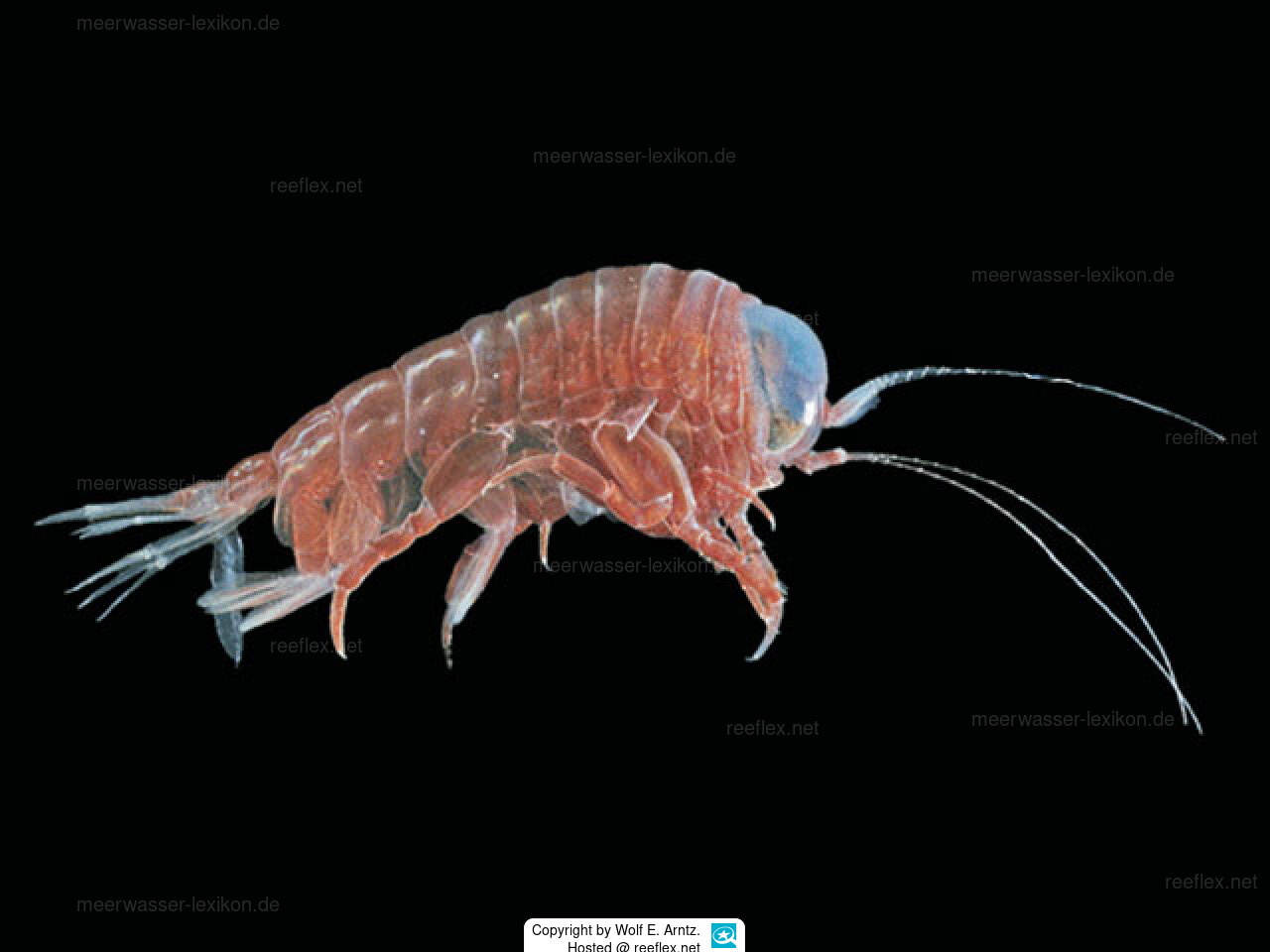Info
Themisto gaudichaudii is a crayfish that lives in swarms and, according to scientific studies, has fewer problems with the warming of the earth and water than krill.
It is already being pondered whether the amphipod can or will displace krill.
Themisto gaudichaudii plays an important role in the food chain like krill, many cartilaginous and bony fishes eat the amphipod, including the following species:
Cartilaginous fish
Squalus acanthias (spiny dogfish)
Bathyraja macloviana (white-nosed stingray)
Bathyraja brachyurops (White-nosed ray)
Schroederichthys bivius (Cat shark)
Bony fish
Austrophycis marginata (Dwarf cod)
Seriolella porosa (blackfish)
Macruronus magellanicus (Southern hake)
Patagonotothen ramsayi (Patagonian icefish)
Micromesistius australis (Southern whiting)
Merluccius hubbsi (Argentine hake)
Salilota australis (Patagonian cod)
Sebastes oculatus (Patagonian redfish)
Dissostichus eleginoides (Black hake
Congiopodus peruvianus (Peruvian pigfish)
Stromateus brasiliensis (Brazilian medusa fish)
Coelorhynchus fasciatus (Banded whiptail)
Merluccius australis (Southern hake)
Themisto gaudichaudii - in varying amounts - was found in the stomachs of these fish.
Basic facts about amphipods:
Members of the order Amphipoda are gonochorous and sexually dimophilic (males larger than females).
Males locate potential mates using their antenna to detect pheromones released by females; then the male rides or carries the female until she is ready to molt.
When the female is ready, the male thrusts the sperm into the marsupium and then releases the female.
A few hours later, the female releases her eggs into the marsupium for fertilization.
Life cycle: The eggs are hatched in the marsupium.
The eggs hatch into young, which remain in the sac for several days. Each species goes through a maximum of 20 molts, i.e. a life cycle of 1 year.
belongs to the zooplankton and is an extremely important component of the diet of seabirds and fish.
Humans must pay more attention to the fact that global warming, which is accompanied by an increase in ocean temperatures and has a lasting negative impact on marine fauna, must be stopped urgently, as it has a lasting negative impact on all living creatures within the food chain, and thus also on humans.
Synonyms:
Euthemisto bispinosa Boeck, 1876
(This is not a valid namestring, it appears in the European Register of Marine Species guide and is not recorded elsewhere in the taxonomic literature. It is presumed that the authors intended to include the correct name Themisto bispinosa Boeck, 1871)
Euthemisto gaudichaudii (Guérin, 1825)
Euthemisto thomsoni Stebbing, 1888
Parathemisto gaudichaudi (Guérin, 1825)
Themisto gaudichaudi Guérin, 1825
It is already being pondered whether the amphipod can or will displace krill.
Themisto gaudichaudii plays an important role in the food chain like krill, many cartilaginous and bony fishes eat the amphipod, including the following species:
Cartilaginous fish
Squalus acanthias (spiny dogfish)
Bathyraja macloviana (white-nosed stingray)
Bathyraja brachyurops (White-nosed ray)
Schroederichthys bivius (Cat shark)
Bony fish
Austrophycis marginata (Dwarf cod)
Seriolella porosa (blackfish)
Macruronus magellanicus (Southern hake)
Patagonotothen ramsayi (Patagonian icefish)
Micromesistius australis (Southern whiting)
Merluccius hubbsi (Argentine hake)
Salilota australis (Patagonian cod)
Sebastes oculatus (Patagonian redfish)
Dissostichus eleginoides (Black hake
Congiopodus peruvianus (Peruvian pigfish)
Stromateus brasiliensis (Brazilian medusa fish)
Coelorhynchus fasciatus (Banded whiptail)
Merluccius australis (Southern hake)
Themisto gaudichaudii - in varying amounts - was found in the stomachs of these fish.
Basic facts about amphipods:
Members of the order Amphipoda are gonochorous and sexually dimophilic (males larger than females).
Males locate potential mates using their antenna to detect pheromones released by females; then the male rides or carries the female until she is ready to molt.
When the female is ready, the male thrusts the sperm into the marsupium and then releases the female.
A few hours later, the female releases her eggs into the marsupium for fertilization.
Life cycle: The eggs are hatched in the marsupium.
The eggs hatch into young, which remain in the sac for several days. Each species goes through a maximum of 20 molts, i.e. a life cycle of 1 year.
belongs to the zooplankton and is an extremely important component of the diet of seabirds and fish.
Humans must pay more attention to the fact that global warming, which is accompanied by an increase in ocean temperatures and has a lasting negative impact on marine fauna, must be stopped urgently, as it has a lasting negative impact on all living creatures within the food chain, and thus also on humans.
Synonyms:
Euthemisto bispinosa Boeck, 1876
(This is not a valid namestring, it appears in the European Register of Marine Species guide and is not recorded elsewhere in the taxonomic literature. It is presumed that the authors intended to include the correct name Themisto bispinosa Boeck, 1871)
Euthemisto gaudichaudii (Guérin, 1825)
Euthemisto thomsoni Stebbing, 1888
Parathemisto gaudichaudi (Guérin, 1825)
Themisto gaudichaudi Guérin, 1825







 Prof. Dr. rer. nat. Wolf E. Arntz, Deutschland
Prof. Dr. rer. nat. Wolf E. Arntz, Deutschland

